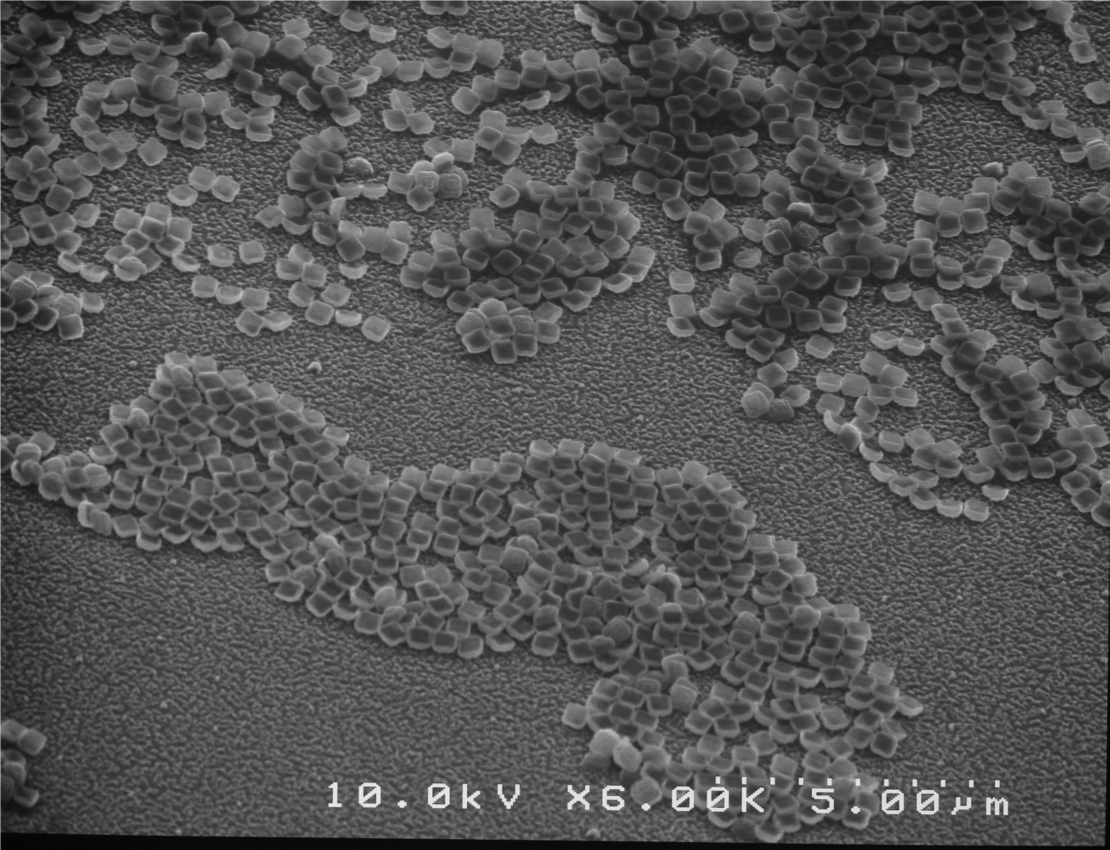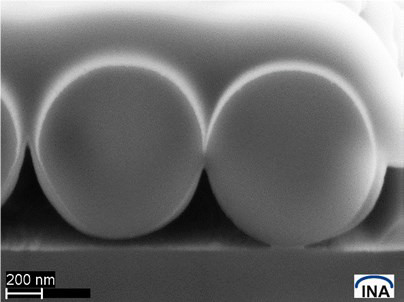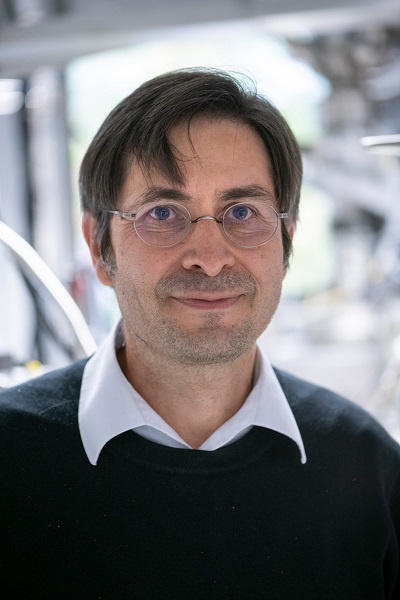Functional thin Films and Physics with Synchrotron Radiation
Ion bombardment induced magnetic modifications of magnetic thin films:
Magnetic thin film systems are the basis for magnetic storage technology or for sensors, molecular carriages, or for magnetic particle propulsion in lab-on-a-chip devices. Light-ion bombardment of magnetic thin films has been developed by the Ehresmann group into a versatile tool to tailor the magnetic characteristics of layers and layer systems and – either by ion beam writing or in combination with lithography – to create almost arbitrary artificial domain structures with associated magnetic field landscapes. In the period under review we could for the first time show the possibility to create complex two-dimensional in-plane magnetized domain patterns in Exchange-Bias layer systems [1] and we applied for the first time a He+ ion microscope for domain writing by He+ ions [4]. Further experiments and theoretical considerations on the impact of light-ion bombardment on magnetic thin films could prove that not only the magnetic anisotropy is changed by the ions but also the saturation magnetization and we observed a swelling of the thin films [2]. Moreover, it could be shown that the ions do not influence all anisotropies similarly, but that the rotational magnetic anisotropy in the investigated polycrystalline layer systems is affected most, a rather surprising result [3].

Transport strategies of magnetic colloids over engineered magnetic field landscapes:
Designed magnetic domains provide designed stray field landscapes that serve as defined positioning sites for magnetic material such as colloidal particles. By superimposing sub-mT external magnetic field pulses, the particles’ magnetic potential energy landscape can be dynamically transformed. This enables a directed transport of the particles in a fluid environment in one [6], two [7], or even three [8] dimensions. Depending on the magnitude and gradient of the stray field landscape above the magnetically patterned exchange bias substrate, the strength and frequency of the external magnetic field as well as the magnetic and electrostatic properties of the particles and the surrounding fluid, not only the transport direction but also the velocity of the particles can be adjusted. The group of Prof. Arno Ehresmann performed extensive research on the theoretical analysis of different transport strategies [6,9] as well as their usage in specific applications such as the transfer of biofunctionalized particles through physiological media for future point-of-care medical analysis systems or the fabrication of switchable optical grating systems [10].

Figure 2: Numerical simulation of the magnetic potential energy landscape of a superparamagnetic spherical particle above a parallel magnetic stripe-patterned exchange bias substrate in dependence on the applied external magnetic fields Hx and Hz. [6]
Design of three-dimensional colloidal magnetic structures:
Functionalizable magnetic particles with variable magnetic and surfaces properties as well as shapes are a very promising tool for cargo delivery in fluid environments. Due to their unique features the transport of the multifunctional particles can be addressed to a specific target which makes them especially suitable for biomedical applications. In collaboration with the group of Prof. Hartmut Hillmer (INA) fabrication methods based on nanoimprint lithography proved to be a successful tool to create particles of arbitrary shapes. By either implementing magnetic material into the particles or subsequently coating them with an exchange bias layer system, the magnetic properties can be specifically tailored [11]. Additionally to this, the group of Prof. Arno Ehresmann focused on the fabrication of spherical Janus particles exhibiting a chemically functionalizable silica sphere and a magnetic cap consisting of an exchange bias layer system. The theoretical description, characterization, arrangement as well as the transport behavior above magnetic stray field landscapes of both particles types has been one of the major research foci during the last years.



Figure 3: Scanning electron microscopy images of cuboid (a) and triangular (b) magnetic particles fabricated by nanoimprint lithography and magnetic Janus particles (c).
References
[1] Gaul et al. (2016): A. Gaul, S. Hankemeier, D. Holzinger, N.D. Müglich, P. Staeck, R. Frömter, H.P. Oepen, A. Ehresmann, J. Appl. Phys. 120, 033902 (2016)
[2] Huckfeldt et al. (2017): H. Huckfeldt, A. Gaul, N. D. Müglich, D. Holzinger, D. Nissen, M. Albrecht, D. Emmrich, A. Beyer, A. Gölzhäuser, A. Ehresmann, J. Phys.: Condens. Matter 29 (2017)
[3] Müglich et al. (2018): N. D. Müglich, M. Merkel, A. Gaul, M. Meyl, G. Götz, G. Reiss, T. Kuschel, A. Ehresmann, New J. Phys. 20 (2018)
[4] Gaul et al. (2018): A. Gaul, D. Emmrich, T. Ueltzhöffer, H. Huckfeldt, H. Doğanay, J. Hackl, M. Imtiaz Khan, D.M. Gottlob, G. Hartmann, A. Beyer, D. Holzinger, S. Nemšák, C.M. Schneider, A. Gölzhäuser, G. Reiss, A. Ehresmann, Beilstein J. Nanotechnol. 9 (2018)
[5] Gaul (2017): A. Gaul, Dissertation – Universität Kassel (2017)
[6] Holzinger et al. (2015): D. Holzinger, I. Koch, S. Burgard, A. Ehresmann, ACS Nano 9 (2015)
[7] Urbaniak et al. (2018): M. Urbaniak, D. Holzinger, A. Ehresmann, F. Stobiecki, Biomicrofluidics 12 (2018)
[8] Ueltzhöffer et al. (2016): T. Ueltzhöffer, R. Streubel, I. Koch, D. Holzinger, D. Makarov, O.G.
Schmidt, A. Ehresmann, ACS Nano 10 (2016)
[9] Loehr et al. (2018): J. Loehr, D. de las Heras, A. Jarosz, M. Urbaniak, F. Stobiecki, A.
Tomita, R. Huhnstock, I. Koch, A. Ehresmann, D. Holzinger, T.M. Fischer, Comm. Phys. 1 (2018)
[10] Koch et al. (2018): I. Koch, T. Granath, S. Hess, T. Ueltzhöffer, S. Deumel, C. I. Jauregui Caballero, A. Ehresmann, D. Holzinger, K. Mandel, Advanced Optical Materials 6 (2018)
[11] Ha et al. (2018): Ha, U.-M., Kaban, B., Tomita, A.-I., Krekic, K., Klintuch, D., Pietschnig, R., Ehresmann, A., Holzinger, D., Hillmer, H., Applied Nanoscience, 1– (2018)
Contact
Prof. Dr. Arno Ehresmann
full member

- Telephone
- +49 561 804-4060
- ehresmann[at]physik.uni-kassel[dot]de
- Location
- Universität Kassel
Fachbereich 10 - Naturwissenschaften & Mathematik
Institut für Physik
Heinrich-Plett-Straße 40
34132 Kassel
- Room
- 1266
